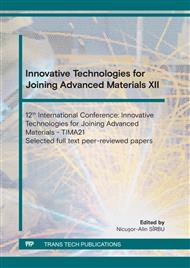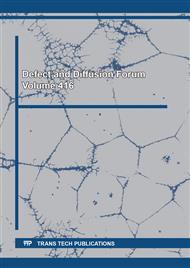[1]
C-M Huang, A. Raj, M. Osterman, M. Pecht, Assembly Options and Challenges for Electronic Products with Lead-Free Exemption, DOI 10.1109/ACCESS.2020.3010771, IEEE Access vol XX, (2017).
DOI: 10.1109/access.2020.3010771
Google Scholar
[2]
Osterman M [and others] Evaluation of faradayic plating method for controlling tin whisker growth,, Maryland, University of Maryland, CALCE EPSC, (2007).
Google Scholar
[3]
Osterman M. Assessing the risk posed by tin whiskers, Retrieved November 27, http://www.calce.umd.edu/lead-free/STMAKeyNote.pdf. 27 11 2006- 15 2 (2010).
Google Scholar
[4]
Jadhav, N., Buchovecky, E., Chason, E., Bower, A., Real-time SEM/FIB Studies of Whisker Growth and Surface Modification. 2010, Vol. 62, No. 7, pp.30-37, glasses by in-situ tensile tests, Materials Science and Engineering A, 2009, 516, p.148–153, ISSN 0921-5093.
DOI: 10.1007/s11837-010-0105-8
Google Scholar
[5]
P. Xue, W. L. Liang, P. He, K. Suganuma, H. Zhang, Tin Whisker Growth Inhibition in RE-Doped Sn-Zn Soldered Joints, Applied Science-Basel, Volume9, Issue7, 2019, Article Number1406.
DOI: 10.3390/app9071406
Google Scholar
[6]
Ashworth A. Mark [and others] An investigation into zinc diffusion and tin whisker growth for electroplated tin deposits on brass, Journal of ELECTRONIC MATERIALS, Loughborough, Leicestershire LE11 3TU, UK, 2014,-.
DOI: 10.1007/s11664-014-2983-y
Google Scholar
[7]
B. Illes, A. Skwarek, J. Ratajczak, K. Dusek, D. Busek, The influence of the crystallographic structure of the intermetallic grains on tin whisker growth, J. Alloys Compd., vol. 785, pp.774-780, (2019).
DOI: 10.1016/j.jallcom.2019.01.247
Google Scholar
[8]
Bunyan D [and others]] Tin whisker growth from electroplated finishes - a review,, Transactions of the Institute of Metal Finishing, 2013, 91(5), pp.249-259,.
DOI: 10.1179/0020296713z.000000000119
Google Scholar
[9]
Crandall Erika R. Factors governing tin whisker growth,- Auburn: A dissertation submitted to the Graduate Faculty of Auburn University Doctor of Philosophy, (2012).
Google Scholar
[10]
H. Johan, S. A. Hall, N. A. Henningsson, J. Engvist, M. Ristinmaa, F. Lenrick, J. P. Wright, Scanning 3DXRD Measurement of Grain Growth, Stress and Formation of Cu6Sn5 around a Tin Whiskers during Heat Treatment, Materials, vol. 12, nr. 446, 2019.
DOI: 10.3390/ma12030446
Google Scholar
[11]
Codrean C., Buzdugan D., Serban, V.A., Voda M., Determination of internal stress in soldered joints with Sn-based alloys by X-ray diffraction, Materials Today-Proceedings, Volume45, Special IssueSI, Part5, Page4364-4366, (2021).
DOI: 10.1016/j.matpr.2021.02.761
Google Scholar
[12]
Şerban, V.A., Codrean, C., Uţu, D., Opriş, C. Amorphous alloys for brazing copper based alloys. The 13th International Conference on Rapidly Quenched and Metastable Materials, Conference Series 2009, 144., 12098, pp.1-4. Journal of Physics, 2009, ISSN 1742-6596.
DOI: 10.1088/1742-6596/144/1/012098
Google Scholar
[13]
Panashchenko Lyudmyla Evaluation of environmental tests for tin whisker assessment,, Maryland, Masters of Science, (2009).
Google Scholar
[14]
K. Lin, J. Wang, C. L. Yang, M. L. Sun, A. M. Hu, Y. W. Wu, H. Q. Ling, M. Li, Growth behavior of tin whisker and hillock on Cu/Ni/Sn/Ag micro-bumps under high temperature and humidity storage, Materials Letters-X, Volume9, 2021, Article Number100060.
DOI: 10.1016/j.mlblux.2021.100060
Google Scholar
[15]
J. Hektor, Tin whiskers: experiments and modelling, Doctoral thesis, Lunds Universitet, 2018, ISBN: 978-91-7753-917-9.
Google Scholar
[16]
Chiu Tsung-Chieh and Lin Kwang-Lung Tin whiskers induced within the unreacted solder are believed to be due to the mechanical stress induced by this IMC rotation, Microstructural electromigration through a Cu/Sn3.5Ag/Au solder joint Scripta Materialia, Elsevier Ltd. 2009, 60, pg. 1121–1124.
DOI: 10.1016/j.scriptamat.2009.02.061
Google Scholar
[17]
Kim K S [and others] Investigation of relation between intermetallic and tin whisker growths under ambient condition,, Microelectronics Reliability,Ed. Ltd. 2007 Elsevier, Science Direct, 2008, 48, p.111–118.
DOI: 10.1016/j.microrel.2007.01.088
Google Scholar
[18]
B. Illés, B. Horváth, Tin whisker growth from micro-alloyed SAC solders in corrosive climate,, J. Alloys Compd., vol. 616, p.116–121, (2014).
DOI: 10.1016/j.jallcom.2014.07.103
Google Scholar



